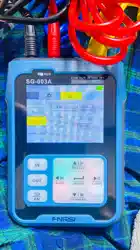Loading ...
Loading ...
Loading ...

【 Parameter Settings 】 :
( 1 ) Mode: It is divided into three modes: single rise, single fall and cycle
( 2 ) Number of loops: 0 is infinite, 30000 is the maximum
( 3 ) Start value: The value at each start
( 4 ) End value: The value at the end of each
( 5 ) Increment step value: The value of each increment
( 6 ) Increment step time: The time between each increment
( 7 ) End stop: The time delay at the end value
( 8 ) Decrement step value: The value to decrease each time
( 9 ) Decrease step time: The time between each decrease
( 10 ) Loop stop: Time delay at start value
【 Supplementary Parameter Description 】 :
The start value and end value of single rise and single fall are selected according to
high and low,and does not automatically close
【 Instructions 】 :
( 1 ) Start and Exit:When the main interface 【 FN 】 is red, press the left key 【 AUTO 】
to start/exit the programming output mode
( 2 ) Up, Down, Left and Right keys: After starting the programming output mode, the
backlight of the up, down, left and right keys will turn blue.The functions of the up,
down, left and right buttons will also change, that is, the top is a single run, the bottom
is a program reset, the left is a single-step run, and the right is a Stop/Continue
【 5.5 】 Real-time Curve
【 Instructions 】:
When the main interface 【 FN 】 is red, press the right button 【 CURVE 】 to switch the
interface with/without curve
【 Parameter Description 】 :
(1) Turn on the output curve: turn on the following display curve of the output
signal (Red line)
(2) Automatic output scaling: automatically adjust the scale range of the output
signal, and automatically adjust the scale range of the y-axis with the maximum
and minimum values of the curve
(3) Input automatic scaling: automatically adjust the scale range of the input signal,
and automatically adjust the scale range of the y-axis according to the maximum
and minimum values of the curve.
(4) Acquisition time: the refresh interval of the curve, and the time scale will also
change with it
��
PAGE
Loading ...
Loading ...
Loading ...
